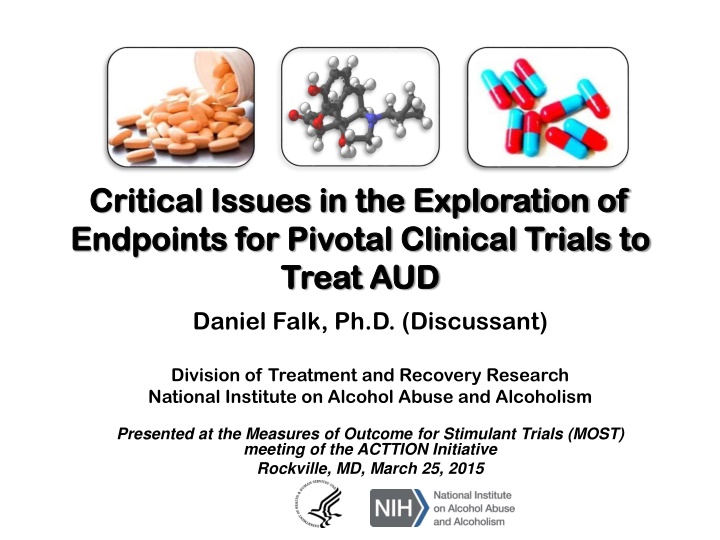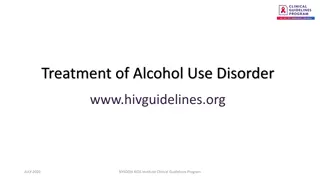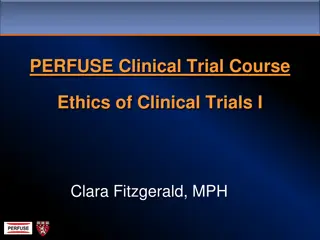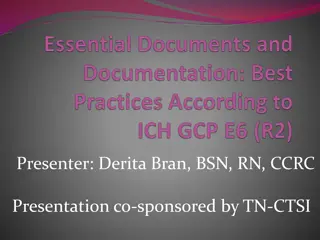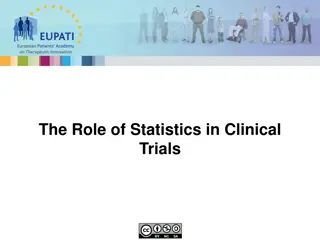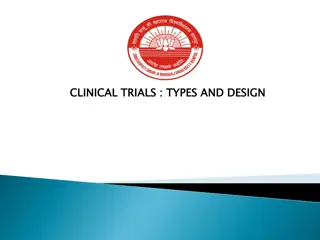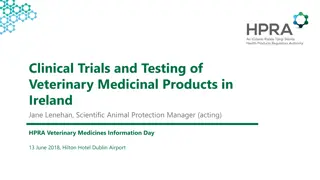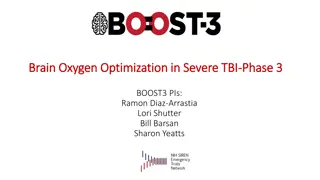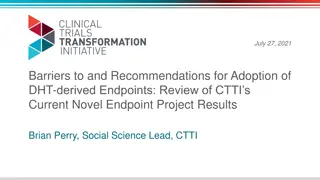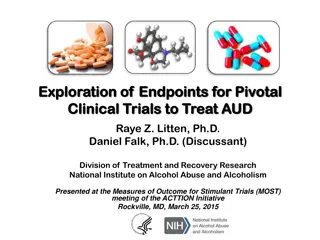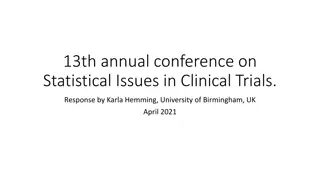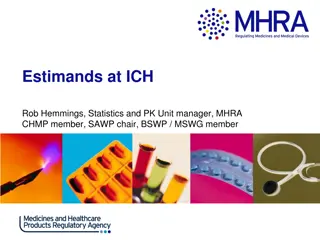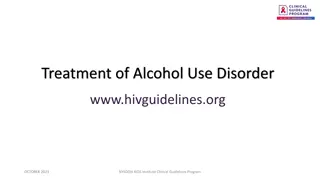Critical Issues in Pivotal Clinical Trials for AUD Treatment
Discussion on key aspects of outcome measures and sensitivity in exploring endpoints for pivotal clinical trials to treat Alcohol Use Disorder. Validation of drinking outcomes, integration of data, and challenges in stimulant trials are highlighted.
Download Presentation

Please find below an Image/Link to download the presentation.
The content on the website is provided AS IS for your information and personal use only. It may not be sold, licensed, or shared on other websites without obtaining consent from the author.If you encounter any issues during the download, it is possible that the publisher has removed the file from their server.
You are allowed to download the files provided on this website for personal or commercial use, subject to the condition that they are used lawfully. All files are the property of their respective owners.
The content on the website is provided AS IS for your information and personal use only. It may not be sold, licensed, or shared on other websites without obtaining consent from the author.
E N D
Presentation Transcript
Critical Issues in the Exploration of Critical Issues in the Exploration of Endpoints for Pivotal Clinical Trials to Endpoints for Pivotal Clinical Trials to Treat AUD Treat AUD Daniel Falk, Ph.D. (Discussant) Division of Treatment and Recovery Research National Institute on Alcohol Abuse and Alcoholism Presented at the Measures of Outcome for Stimulant Trials (MOST) meeting of the ACTTION Initiative Rockville, MD, March 25, 2015
Discussion Issues Discussion Issues What makes a good outcome measure? Sensitivity of alternate drinking & non- drinking outcomes Issues validating drinking outcomes: Data issues What are the most important validation outcomes? How do we decide among them? How integrate data? Challenges for stimulant trials
What makes a good outcome measure? 1. It is clinically meaningful: e.g., a response variable that sets a threshold by which a clinician might judge a patient to be well or to have gotten better. 2. It can be achieved by a sizable proportion of patients. 3. It is validated against (correlated with) other informative outcomes: Drinking Consequences (DrInC) Physical health markers (e.g., blood pressure) Global indicators of well-being (e.g., SF-12 Quality of Life) 4. It is sensitive to the effect of medication It is more sensitive than other outcome measures (or at least no less sensitive). 5. It has the support of key stakeholders Consensus of regulatory agencies, researchers, clinicians, patients, policy makers, and payers
Sensitivity of Sensitivity of Alternate Drinking Alternate Drinking & & Non Non- -drinking Outcomes drinking Outcomes (be careful what you wish for, (be careful what you wish for, you might get it) . you might get it) .
Alternative Drinking Outcomes can be LESS Sensitive EMA responder definition: Who Risk Level Definition Reduction in drinking by 2 or more risk levels from baseline to treatment Men: none Women: none Abstinence Men: 1-40g (<2.9 drinks) Women 1-20g (<1.4 drinks) Low Very High to Medium risk (or lower) High to Low risk (or Abstinence) Men: 40-60g (2.9-4.3 drinks) Women 20-40g (1.4-2.9 drinks) Medium Men: 60-100g (4.3-7.1 drinks) Women 40-60g (2.9-4.3 drinks) High Men: 100+g (7.1+ drinks) Women 60+g (4.3+ drinks) Very high World Health Organization s gender-specific levels of risk Standard drink = 14g = 0.6 oz of alcohol
Alternative Drinking Outcomes can be LESS Sensitive (COMBINE) Measure Type Drinking Measure P Cohen d or h continuous % heavy drinking days <0.01 .23 continuous drinks/day 0.02 .19 continuous drinks/drinking day 0.01 .21 continuous % days abstinent 0.01 .21 dichotomous PSNHDD <0.01 .22 dichotomous % subjects abstinent 0.06 .15 dichotomous % subjects reduce by >2 WHO levels 0.05 .16 6 Preliminary Study - Please do not distribute
Alternative Drinking Outcomes can be LESS Sensitive EMA Responder Definition EMA Responder Definition: : proportion of subjects with an alcohol reduction of 70%, 50%, 90%, 100% (abstinence) Topiramate Study (Weeks 7-14) Placebo Topiramate h 100 1.0 90 0.9 80 0.8 Proportion of Responders (%) 70 0.7 Treatment Effect (h) 60 0.6 * 50 0.5 * * * * * * * * 40 0.4 * * 30 0.3 20 0.2 10 0.1 0 0.0 0 5 10 15 20 25 30 35 40 45 50 55 60 65 70 75 80 85 90 95 100 Minimum Relative Reduction in Drinks per Day from Pretreatment Falk et al., J Stud Alcohol Drugs 75:335-346, 2014
Alternative Drinking Outcomes can be LESS Sensitive Topiramate Study (Weeks 7-14) Placebo Topiramate h 100 1.0 90 0.9 80 0.8 Proportion of Responders (%) 70 0.7 Treatment Effect (h) 60 0.6 50 0.5 * * * * 40 0.4 30 0.3 20 0.2 10 0.1 0 0.0 20 19 18 17 16 15 14 13 12 11 10 9 8 7 6 5 4 3 2 1 0 < X Drinks per Day during Treatment Falk et al., J Stud Alcohol Drugs 75:335-346, 2014
Non Non- -Drinking Outcomes: Drinking Outcomes: Desirable, but Sensitive? Desirable, but Sensitive? Drinking as a surrogate for non-drinking outcomes: The aim of treatment is often expressed as an effort to modify drinking behavior, but the actual desired effect is improvement in physical and psychosocial consequences. FDA Draft Guidance Limited sensitivity?
Insensitivity of Non Insensitivity of Non- -Drinking Outcomes: Drinking Outcomes: ( (COMBINE) COMBINE) DrInC score (total) NS, d=.11 Blood Pressure NS LoCastro et al. 2009. J Stud Alc Drugs, 70:186-191 Falk et al., 2010. Alcohol Clin Exper Res, 34:2022-2034; and unpublished.
Issues Validating Issues Validating Drinking Outcomes Drinking Outcomes
Relative Strengths of Datasets for Validating Drinking vs. Consequences Measure Rehm s Chronic Disease COMBINE, MATCH, RREP, varenicline NESARC Kaiser Drinking + +++ ++ ++ Chronic Consequences ++ ++ +++ Acute Consequences +++ ++ +++ Study Design + +++ +++ +++ Blank = poor + = fair ++ = good +++ = excellent
Blood Pressure: Blood Pressure: Which outcomes to validate? Which outcomes to validate? Against what consequences? Against what consequences? Outcomes 1. Systolic BP 2. Diastolic BP Consequences Mortality Morbidity Myocardial infarction Heart failure Stroke Revascularization surgery Renal disease James et al. 2014. JAMA 311:507-520
Drinking Drinking Which outcomes to validate? Which outcomes to validate? Against what consequences? Against what consequences? Chonic Mortality AUD / other substance Mental health disorders Heart Caridomyopathy Arrythmia Stroke Blood pressure Liver Fatty liver Alcoholic hepatitis Fibrosis Cirrhosis Pancreas Immune System HIV/STD infection Diabetes Epilepsy Cancer Mouth Espohagus Liver Breast Acute DrInC (45 items in 5 classes): Physical Social responsibility Interpersonal Intrapersonal Impulse control Outcomes Drinks/day Drinks/drinking day Days abstinent Heavy drinking days (4/5) Very heavy drinking days (8/10) Extreme heavy drinking days (10/12) Biomakers (%CDT, GGT, pETH, etc) 1. 2. 3. 4. 5. 6. 7.
Challenging question Challenging question How integrate data to: a) validate a given clinical trial result of a continuous outcome b) create/validate a responder definition, given the myriad consequences by which to validate them? Placebo Placebo Medication RR=2.0 Medication 50 25 Alcohol Consumption (g/day) Alcohol Consumption (g/day)
Endpoints: Endpoints: Challenges for Stimulant Trials Challenges for Stimulant Trials Difficulty obtaining quantity consumed, only frequency (e.g., percent days abstinent) and percent subjects abstinent? With frequency, need to evaluate clinical relevance Develop sensitive non-substance intake endpoints (e.g., health, drug-related consequences, treatment utilization, psychosocial function, etc.) Before the effort of evaluating clinical relevance of new endpoint, test its sensitivity of detecting a treatment effect using various data sets
